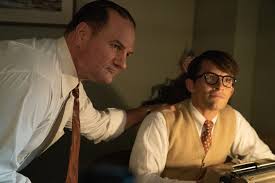Based on the novel by Thomas Mallon and adapted by Ron Nyswaner, “Fellow Travelers” follows two gay men who meet at the height of McCarthyism and trace their romance over decades, from the ’50s to the ’80s. If this reminds you of another film, it’s “The Way We Were,” with Jewish being replaced by Queer, Robert Redford’s golden boy Hubbell Gardiner morphing into tall, dark, and handsome Matt Bomer’s Hawkins Fuller, and Barbra Streisand’s lovestruck Katie Morosky becoming the Catholic and bespectacled Tim Laughlin, played by Jonathan Bailey.

The series opens with the “Lavender Scare” of the early 1950s when hundreds of LGBTQ+ men and women lost their government positions during the anti-communist and anti-gay witchhunts of the early Eisenhower/Nixon era. Nyswaner skillfully weaves a story that involves both fictional and real-life characters. The audience is introduced to Senator Joe McCarthy (played by Chris Bauer) his bulldog Roy Cohn (played by Will Brill), and Cohn’s pretty boy David Schine (Matt Visser) the heir to a hotel chain fortune (Lillian Hellman dubbed them “Bonnie, Bonnie, and Clyde.”) Cohn, who was responsible for sending the Rosenbergs to the gas chamber and was featured prominently as a character in “Angels in America,” was both a victim and complicit in homophobia and died from an AIDS-related illness; McCarthy had numerous gay one-night stands, while the relationship between Cohn and Schine has always been a mystery. These men interact with Hawkins and Tim at cocktail parties and government functions, constantly just a heartbeat away from destroying their lives and careers. However, it was one of McCarthy’s affairs in the gay demimonde that ended up being one of the many things that killed him.

Tim, who initially works in McCarthy’s office, falls madly in love with Hawkins, a person who knows the ropes and will do anything to protect his government career, including marrying his boss (the fictitious Senator Smith, a McCarthy opponent, played by Linus Roach) ’s daughter, the long-suffering Allison Williams. Like Barbra’s Katie, this leaves Bailey’s Tim out in the cold, a life wasted pining for someone who can never reciprocate their love. There is, however, a trove of deliciously explicit if predictable sex scenes with Bomer’s Hawkins always aggressively on top and Bailey’s Tim a very submissive bottom.

In addition to the main storyline, the movie has two subplots that involve LGBTQ+ characters. The first one revolves around a Black journalist, played by Jelani Alladin, who has a drag queen boyfriend – oh, that old cliche! The other subplot features a lesbian government employee, played by Erin Neufer, who has a girlfriend that she abruptly and callously throws under the bus when the ax begins to fall. Unfortunately, these storylines seem to be included solely for diversity; they come across as mere padding and distract from the main plot.
Overall, it’s compulsively watchable, just not a classic.
https://thebrownees.net/essay-one-1-2-65-queer-films-under-the-hays-code-1934-1967/
https://thebrownees.net/essay-one-1-34-queer-films-made-under-the-hays-code-1934-1956/
https://thebrownees.net/essay-one-2-31-queer-films-made-under-the-hays-code-1957-1967/
https://thebrownees.net/essay-one-table-65-queer-films-made-under-the-hays-code-1934-1937/
https://thebrownees.net/essay-two-45-queer-films-from-1967-1976-queer-cinema-comes-out/


















